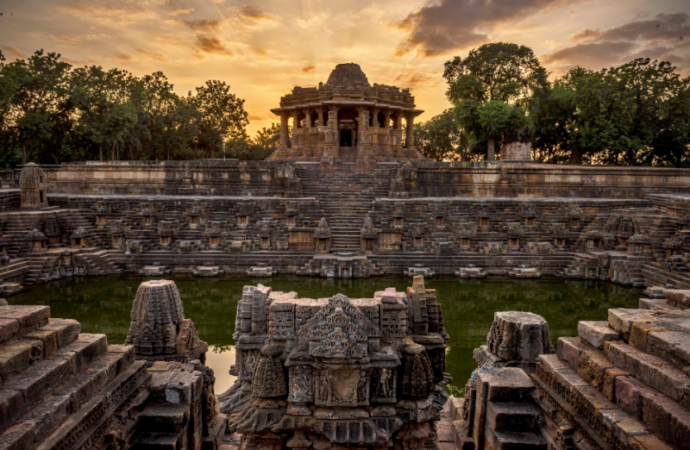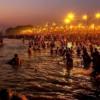The Modhera Sun Temple was made to honour the Hindu deity Sun God in Modhera village of Mehsana district which is situated on the bank of River Pushpavati.
Ancient temples have always signified one of the most marvellous threads in the tapestry of Indian culture and history, and Gujarat certainly has a magnificent assortment of temples to view when mapping out your next tour to the state.
The Modhera Sun Temple was made to honour the Hindu deity Sun God in Modhera village of Mehsana district which is situated on the bank of River Pushpavati. The temple was made by King Bhima I of the Chalukya dynasty in the early 11th century. No prayer is offered now and is a preserved monument managed by the Archaeological Survey of India.
Architecture
The temple is designed in such a form that during every equinox, the first glimmer of the rising sun falls on a diamond laid on the head of the Sun God. This would also brighten up the shrine with a golden radiance. The place was later acknowledged as Sita ni Chauri and Ramkund locally
The temple complex is subdivided into three parts – Gudha Mandapa (the shrine hall), Sabha Mandapa (the assembly hall) and Kunda (the reservoir).
The Sabha Mandap stands on 52 pillars, manifesting 52 weeks in a year. There are carvings and sculptures of the sun on the walls to explain its uniqueness with air, water, earth and space.
The pillars of Sabhamandapa and Gudhamandapa are of two types; short and tall. The short pillars halt on the walls and support the roof. The tall pillars rise from the floor
The Garbhagriha, the shrine proper or sanctum sanctorum is square measuring 11 feet from the inside. The walls in the interior of the shrine are plain and the exterior wall is illuminated. The doorway has sculpted statues of desked Suryadev in panels encompassed by dancers and devoted couples. All configurations are damaged and the models on the door lintel are entirely demolished.
Kunda, a tank or reservoir is known as Ramakunda or Suryakunda. The flight of steps through Kirti-Torana guides to the reservoir.
The stepwell on the west of Kunda has one incoming way and two arcade columns. It is pretty embellished.
The door frame has lotus and leaves and the ruchaka-kind pilasters symbolise it refers to the 11th century. The small mandapa above the ground level and positioned on the second Kuta of stepwell may belong to the 10th century.
History
On a block in the western wall of the cella, there is an inscription “Vikram Samvat 1083” upside down carelessly incised in Devnagari script which corresponds to 1026-1027 CE
Modhera finds a mention in the ancient scriptures like Skanda Purana and Brahma Purana. The ancient texts also relate to Modhera and its neighbouring areas as Dharmaranya or the forest of righteousness.
As the inscription is upside down, it evidences the destruction and reconstruction of the cella. Due to the position of the inscription, it is not firmly considered as the date of construction. On the stylistic ground, it is known that the Kunda with its corner shrines was built earlier at the beginning of the 11th century.
The inscription is rather considered as the date of destruction by Ghazni instead of the construction. Soon after Bhima returned to power. So the temple proper, the miniature and the niche shrines in the tank were built shortly after 1026 CE. The dancing hall was attached much later in the third quarter of the 12th century along with the gateways, the porch of the temple proper and the doorframes of the temple.
This splendour temple of the Sun-god not only depicts the king’s devotion towards the god but also shows the marvellous methods and techniques he used to build this magnificent masterpiece.
Did You Know:
- In 2014, Modhera Sun Temple entered the list of UNESCO World Heritage Sites.
- Gujarat government is all set to launch a first-of-its-kind 6 MW solar power project in the country in which the Modhera village will be provided 24X7 solar power.
- Work on the project is likely to be over by July 15 and it is also likely to be inaugurated by Prime Minister Narendra Modi.
- Letitia Elizabeth Landon’s poetical illustration Hindoo and Mahommedan Buildings refers to an illustration of “a splendid sculptured Portico of a Temple dedicated to Mahadeo, at Moondheyra in Guzerat” and in it, she meditates upon the vastness of this structure.

























Leave a Comment
Your email address will not be published. Required fields are marked with *